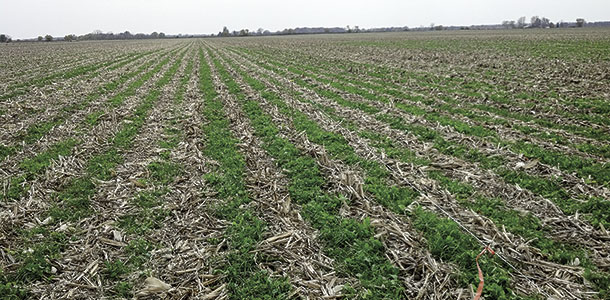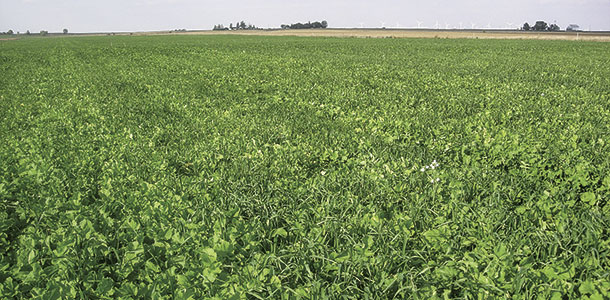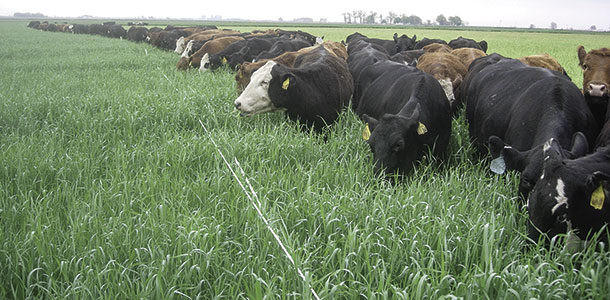When the question of what to raise on a piece of ground is no longer restricted to corn or beans but simply becomes about producing a quality feedstuff, a whole world of opportunity presents itself.
Livestock grazing on cover crops can bring a whole new dimension of cropping systems into the Midwest. It certainly takes a new approach to management. A producer has to be willing to make mistakes, but I believe there is opportunity for more profit per acre.
We began 13 years ago in Illinois with the purchase of six cow-calf pairs and seeded 8 acres of farmground to an alfalfa-grass mix. Today, we run an 85-head cow-calf operation with about 100 acres of “permanent” pasture and utilize another 350 acres of row-crop ground for grazing of cover crops and annuals in between corn, soybean and wheat crops.
We utilize a few different crops and cover-crop rotations to try and maximize return. Some have proven very reliable while we are still figuring out ways to make others work.
One rotation that works particularly well is a corn-soybean-wheat rotation, planting cereal rye after corn and a combination of oats and radishes after the wheat crop.
Cereal rye has proven to be the most reliable cover crop for us, both in grazing and strictly row-crop circumstances. It is extremely winter-hardy, withstands late-fall planting and provides good early spring growth for grazing before most pastures are ready.

Oats and radishes following wheat have also been very effective. They make an extremely high-quality forage for late-fall and early winter grazing for cattle and young calves. This simple crop rotation allows us to extend the grazing season on both ends in a very reliable way.
Cereal rye is best utilized in the early spring and gives good-quality forage for a fairly short period of about three weeks. We generally expect 2 tons to the acre of good feed from the rye in this time period.
Weather conditions at this time can be variable, and rain often makes field conditions muddy. We restrict the grazing with temporary fences to limit cattle from ruining the feed.
Fields will often times get pretty mucked up, but we have had good success planting soybeans after the rye. It seems any added compaction issues for the soybeans are made up for by the manure and additional year in the crop rotation.
We make a point to remove the cattle from the oats and radishes by mid-winter since that ground will be used for corn production the next year. Removing them early allows for some freezing and thawing to loosen the topsoil and take care of any surface compaction.
We are generally no-till and strip-till on our farm, and while proper management is important, we don’t think there is any long-term issue with compaction, and in fact with the use of deep-rooting crops like radishes and annual ryegrass, deep compaction can be alleviated while still grazing.

There are, of course, many more options available for grazing and livestock feed. We are exploring ways to make things work for more regular corn and soybean rotations. Cereal rye again works well in these circumstances, but we also want to take advantage of grazing cornstalks in the fall and winter.
If conditions are relatively dry and grazing is controlled, cereal rye can be grazed in the fall with cornstalks and still be used in the spring. However, wet conditions and potential overgrazing mean we generally like to leave our spring-grazed fields untouched in the fall.
Aerial applications of annual ryegrass and turnips or radishes into standing corn have worked excellent in some years, but in years of later harvests this does not produce enough feed for fall grazing.
Annual ryegrass, when established early, shows good overwintering and provides an excellent feed in the spring with a longer window of good quality than cereal rye, but potential for winterkill in our area has left us utilizing it as aerially applied fall grazing.
Our permanent pasture system consists primarily of what was formerly corn and soybean ground which, while flat, would be considered tough ground by most standards. But again, open fields make fencing and figuring out logistics much simpler and more economical.

Our grazing of permanent pasture oftentimes only comes down to a total of four to four-and-a-half months, making a fairly high stocking density based on actual pasture ground out of production.
We have become big believers in reseeding worn-out pasture stands to keep production high. We currently rely on alfalfa-grass mix pastures with occasional warm-season annuals in between when time to reseed the pasture.
Of course, logistics will be one of the biggest barriers to grazing more cover crops. While we are fortunate to have most of our land close together, our cattle still need to be moved two to three times a year by trailer. Water, shade, shelter, mineral feeders and handling facilities must all be planned.
Fencing in a square 40- or 80-acre field with high-tensile fencing is surprisingly inexpensive, making it a viable option even for fields not being grazed every year. However, fenceline maintenance is always an issue, primarily keeping weed and grass growth under control.
In warm weather, hauling water or using plastic pipe laid on top of the ground can be a manageable means of getting water to cattle, but by the time cold weather sets in, we want to be sure cattle are somewhere close to the well and stock tank heaters.
And of course, handling facilities of some kind are essential. If cattle are frequently moved to different fields, these will usually be temporary in nature. Oftentimes simply a corral with some means of loading an animal will be sufficient.
We continue to learn and, like most producers, have found more ways not to do something than to do it right. I have no doubt that another 10 years down the road, our system will be quite different than the one we use today, but the importance of producing good-quality forage at low cost will always be top priority. FG
Jim Isermann is a producer from Ashkum, Illinois, and presented at the American Forage and Grassland Council Annual Conference.
PHOTOS
PHOTO 1: These cattle are grazing cereal rye in the springtime, restricted by a temporary fence for rotational grazing.
PHOTO 2: This field shows turnips and annual ryegrass aerially seeded into standing corn after harvest.
PHOTO 3: These cattle are grazing turnips and oats drilled after a wheat crop harvest.
PHOTO 4: This field was seeded to oats and radishes following a wheat crop. Photos courtesy of Jim Isermann.
Jim Isermann
Producer from Ashkum, Illinois
Email Jim Isermann








